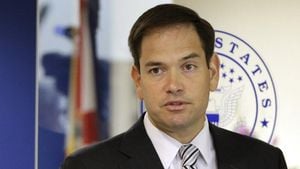With the dust settling on the 2024 U.S. presidential election, the results are drawing attention not only for their dramatic shifts but also for the complex narratives they reveal about American politics.
Former President Donald Trump has emerged victorious over Vice President Kamala Harris, marking his return to the presidential stage with his most decisive win to date. This election marks significant changes not only at the top of the ticket but across various races nationwide, reflecting shifting demographics and changing voter sentiments.
Florida, long seen as the quintessential battleground, has transformed dramatically with Trump winning by 13 points, improving his margins from 3.4% in 2020 and 1.2% back in 2016. At the heart of this Republican resurgence is the fact the election results show record support among Hispanic and Latino voters, especially within Miami-Dade County. Trump garnered approximately 58% of the Latino vote, according to exit polls, compared to Vice President Biden’s 46% during the 2020 election.
The former president claimed six million votes statewide—the highest tally for any presidential candidate—while Florida’s own Senator Rick Scott also secured his seat with notable margins, defeating Democratic challenger Debbie Mucarsel-Powell by almost 13 points. Political analysts say the shifting political climate favors Republicans, with trends seen as deeply rooted over years of migration and demographic changes, particularly with older Americans moving to the state.
On the other hand, Trump's victories were equally matched by stark backlash campaigns from Democrats struggling to navigate the rapid shifts. Political experts argue the ground game executed by state Republicans has vastly outperformed their Democratic counterparts, especially within minority communities increasingly leaning toward the GOP.
Looking northward, Pennsylvania has played host to trends of its own. Trump’s election win here reflects a broader narrative of realignment. The Keystone State saw Republicans sweeping every level of elected office, marking the first such occurrence since 1980—a shift attributed significantly to changing attitudes among working-class voters and the influx of Latino voters aligning with Trump's economic messages.
The dramatic changes along Route 309—a highway once symbolizing Democratic stronghold—tell the story of this political transformation. Areas historically drawn toward the Democratic Party have flipped as demographics shift, showcasing Trump carrying Hazleton by 62% overall and winning every ward, even as he found huge support among Latino voters.
“It’s ironic,” shares local resident and longtime voter Mark Donahue, “who’d have thought you’d see this kind of push for Trump where people used to root for Democrats? The economy speaks and people are listening.” This sentiment echoed throughout portions of Schuylkill County, where Trump amassed 71% of the vote, leaving Democratic hopes withering.
Among the changing tides, some analysts remark on the challenges facing Democrats moving forward. State-level leaders like Senator John Fetterman and Governor Josh Shapiro bring hope for the party, but they will face significant hurdles if working-class voters continue their rightward lean. The urgency to re-engage communities disillusioned by Democratic policies lingers heavily on their shoulders.
Simultaneously, Harris faced criticism for her campaign strategies, particularly around courting Polish-American voters as she concentrated on the war in Ukraine—an approach some deemed ineffective. Many voters expressed their primary concerns surrounding inflation and felt disconnected from the senator’s messaging, as evidenced by lukewarm enthusiasm across numerous polling districts.
Beyond Pennsylvania, different narratives unfolded nationally, emphasizing both concerns and optimism from various party platforms. Statements from Democratic Party leaders reflected dire outlooks post-election, with Florida Democratic Party Chair Nikki Fried proclaiming, “Our fight is not over.”
The battle is not strictly about votes, but also about ideals. For large urban centers like Philadelphia, where Harris garnered favor with substantial youth and minority districts, Trump made notable gains, indicating changing narratives within traditionally Democratic precincts. Political strategists see this as symptomatic of shifts needing to be addressed rather than circumvented.
Back to Florida, recent constitutional amendments voted on during the election also signal broader concerns of both parties, with recreational marijuana and abortion rights unable to gather the necessary support needed to pass. Polls indicated these issues held majority favor among voters, reinforcing the notion the electorate may not be as uniformly conservative on social policy as the election results suggested.
“This juxtaposition of strong conservative gains alongside significant social issues failing to pass makes for perplexing dynamics as we move forward,” said political analyst Sean Freeder. The backlash against the constitutional amendments signifies not only disagreement with Republican control but also hints at the necessity for nuanced policies appealing to Floridians’ progressive leanings.
Delving back to Andrew Yang, former presidential candidate who spoke candidly at election rallies, he emphasized the importance of remaining engaged and accommodating diverse voter narratives. He approached the conversation focusing on outreach rather than isolation, leading discussions around addressing constituents' divergent values.
The election reinforced the importance of local dynamics intertwined with national sentiments. Harris called for unity but the tangible prevention of dissent from progressive factions within her own party serves as notable reality checking moving forward. With multiple elections culminating amid increasing polarization, the need for effective outreach strategies—bridging the ever-widening gap of differing ideologies—becomes more pertinent than ever.
The outcomes of the 2024 presidential elections will undeniably shape subsequent policies and party strategies as the battle for the hearts and minds of Americans continues. Looking ahead to the midterms and beyond, both parties face the unique challenge and opportunity to rethink strategies and cultivate connections, ensuring voices across the spectrum are truly heard.



